Is Santa Real? Learn the Origin Story of St. Nick (original) (raw)
Yes, Virginia, there is a Santa Claus! Here's the truth about the man behind the myth—and how he turned into the figure we know today.
Now Trending
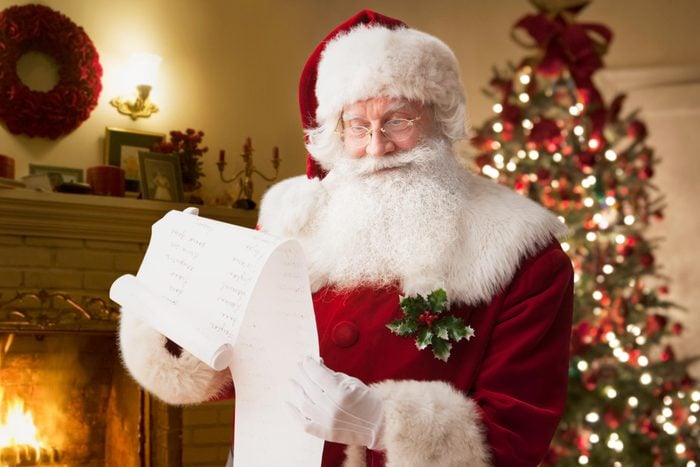
Jose Luis Pelaez Inc/Getty Images
The real story behind Santa
Every child who celebrates Christmas can tell you about Santa Claus: He wears red and white, flies a sleigh pulled by reindeer, delivers toys and, these days, even has apps dedicated to tracking him. But is Santa real? Kids would say he is—and they’d be right. Well, not Santa himself. But his namesake, Saint Nicholas, certainly existed.
St. Nicholas lived nearly two thousand years ago, and the story of how he morphed into Santa is the stuff of legend. His tale travels from Europe to America and back again, leaving cookie crumbs along the way. “He was a very, very popular saint—the Taylor Swift of saints, even though we know very little about him,” says Robert Thompson, a Syracuse University professor of pop culture. “The great stories of St. Nicholas had the seeds of what would be really useful when the 19th century needed a symbol for a holiday that would become the greatest retail festival of all time.”
St. Nicholas turned into one of the most well-known and internationally beloved Christmas symbols of all time—indeed, what is Christmas today without the man with the bag? Jolly Old St. Nick lends an unforgettable sense of magic to Christmas Eve, but let’s explore how he got there, with the help of our Santa experts.
Get _Reader’s Digest_’s Read Up newsletter for more holiday history, humor, cleaning, travel, tech and fun facts all week long.
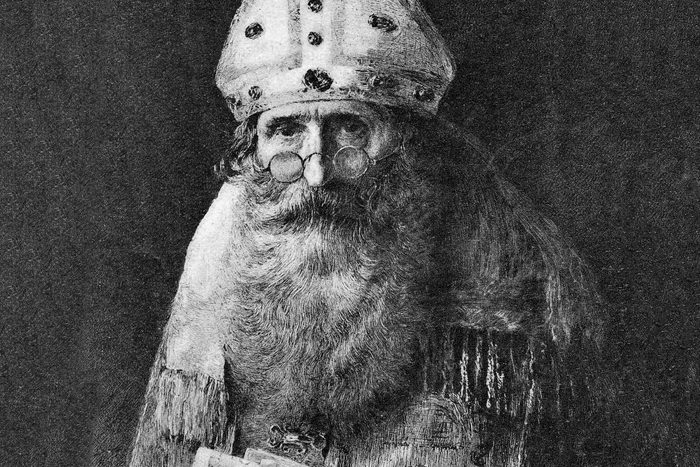
Bettmann/Getty Images
The connection between St. Nicholas and Santa Claus
The real St. Nicholas was a fourth-century bishop from the city of Myra, which is now in Turkey. “We know precious little about St. Nicholas,” Thompson says. “St. Nicholas reminds me of Shakespeare: We have very little data that’s hard and fast, and we don’t even know if he actually existed.” The bones in his grave are considered holy relics, though, and a 2017 Oxford University examination of them found that they are of the right time period and therefore could be proof the man did exist.
There are plenty of stories—legends, really—about him. He’s known for his anonymous gift-giving, as in the tale of a man who has no money for his three daughters’ dowries, which would leave them to a fate of prostitution. “Nicholas hears about this, and depending on the version of the story you read, their stockings are hanging out, and he fills them with coins, and they’re able to have a dowry,” Thompson says. Then there’s an even more bizarre yarn. “Three little boys are boiled in a pot, and he brings them back to life,” he says.
In spite of, or maybe because of, these strange tales, St. Nicholas became very popular over the centuries. “He was a really adaptable saint because he was the saint of all kinds of things, from sailors to children,” Thompson says. “There were St. Nicholas churches all over the place,” including the Netherlands, where the celebration of St. Nick’s feast day on Dec. 6—conveniently close to Christmas—gave rise to a Dutch version of the saint known as Sinterklaas.
Which brings us to New Amsterdam, aka New York City, originally settled by the Dutch. “If what we know today as Santa Claus lives in the North Pole, he was born in New York,” Thompson says. “These various stories and ideas made their way across the Atlantic to the United States, to New York. And then in that usual American super-sized, consumer-oriented way, [we] transformed them.”
Using the Dutch culture of the area, early 19th-century author Washington Irving—who’s more associated with Halloween, as the inventor of Sleepy Hollow and the Headless Horseman—gave the first hint of our modern Santa Claus in 1809. “Washington Irving in his Knickerbocker’s History of New York includes some very early important elements of the modern Santa Claus that we know, including a [flying wagon] that was drawn by horses,” Thompson says. Irving’s jolly St. Nick would also drop gifts down chimneys. “Irving gets things started and primes New York as this place where the modern American Santa is bubbling up.”
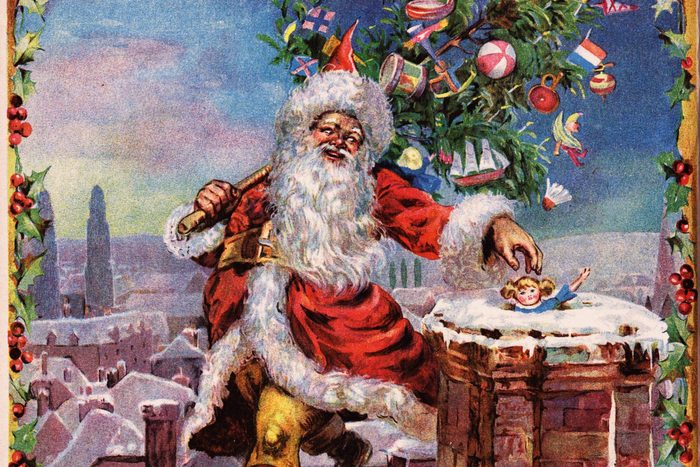
Transcendental Graphics/Getty Images
The origin of Santa Claus
Anyone asking “Is Santa real?” deserves a better understanding of how St. Nicholas transformed into the Americanized symbol we’re familiar with today. Santa in America really came to life with the 1823 Christmas poem “A Visit from St. Nicholas,” now commonly called “‘Twas the Night Before Christmas,” credited to the scholar and Irving’s fellow New Yorker Clement Clarke Moore (although the true author is up for debate).
“That poem reads much like today’s Santa,” Thompson says. It incorporates all the modern trappings of Santa: the rosy nose, the white beard, the fur outfit, the bundle of gifts for kids, even his reindeer’s names (the reindeer themselves first appeared two years earlier in the poem “Old Santeclaus with Much Delight”). “A Visit” builds on Irving’s vision, even borrowing the pipe and the near-direct quote, “laying his finger aside of his nose.”
Visually, artists began incorporating this jolly, round-bellied Santa into illustrations. Civil War cartoonist Thomas Nast drew one of the first recognizable Santas in 1862 in Harper’s Weekly and continued for more than 20 years. “Thomas Nast, over the course of many years, is developing Santa and plumping up his physique,” Thompson says.
He says Santa was a perfect figure for the Industrial Revolution of the 19th century, which brought about an increase in commerce—and the commercialization of Christmas. “The whole birth of modern consumer culture that very much starts in the 19th century helped motivate the invention of Santa Claus, the American version,” Thompson says. “If Santa Claus comes from a saint, it makes it a little bit more sacred; this is not simply retail or consumer-driven. This is not simply a god of consumption.”
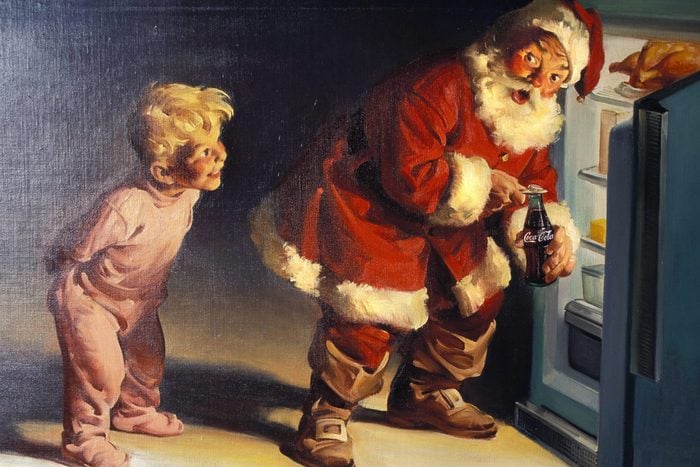
Pool BASSIGNAC/REGLAIN/Getty Images
Santa’s rise to fame
The 20th century solidified the American Santa so much that asking “Is Santa real?” is now a rite of passage for American children. Some of the most famous images of the modern Santa came with the Coca-Cola advertisements drawn by artist Haddon Sundblom, starting in 1931. “They were everywhere,” Thompson says. “Those were beautiful pictures. I remember actually taking a little kitchen knife and pulling out one of those pictures, and I hung it up as a Christmas decoration in my bedroom.”
Another big way to sell Santa? Department store Santas and, later, mall Santas. “That was a sense of taking this idea that up until that point had only been in literature and illustrations, and putting Santa Claus into actual physical space,” he says. Thus began the Christmas tradition of kids sitting on Santa’s lap and asking for what they want for Christmas. “That also put Santa Claus in the place he really was the emperor of: the retail establishment.”
Rudolph, the ninth reindeer, also has his roots in consumer culture, starting off as a promo book for the retailer Montgomery Ward in 1939 before becoming a hit Christmas song in 1949 and an animated special in 1964. “The special became a huge hit and continues to be a huge hit,” Thompson says. “If you’re under 60, you just grew up assuming Rudolph was the front reindeer, and it comes as a great surprise to realize Rudolph was a Montgomery Ward advertising creation.”
Add in Christmas movies like Miracle on 34th Street and a host of new Christmas songs focused on the big guy, and you’ve turned out a modern holiday figure from a third-century saint. “Santa Claus was retrofitted to St. Nicholas from the start,” he says.
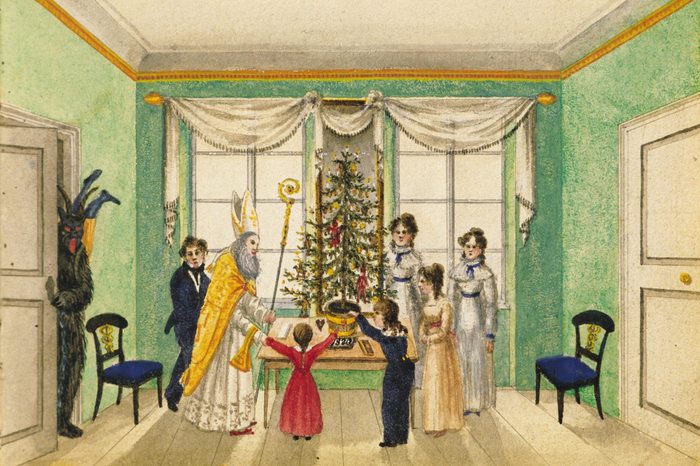
brandstaetter images/Getty Images
How Santa Claus got his name
If the names St. Nicholas, Sinterklaas and Santa Claus all sound alike, that’s not a coincidence. “You could say St. Nicholas fast, and it becomes Santa Claus,” Thompson says. Sinterklaas itself is a shortened form of Sint-Niklaas, which is Dutch for St. Nicholas. “The language gives a signpost to how these various lines of cultural evolution happened,” Thompson says.
Although the term Santa Claus is an American invention, no one is exactly sure when the name was created. The first time it appears in print is in a 1773 newspaper, Rivington’s New-York Gazetteer: “Last Monday, the anniversary of St. Nicholas, otherwise called St. a Claus, was celebrated at Protestant Hall, at Mr. Waldron’s, where a great number of the Sons of that ancient Saint celebrated the day with great joy and festivity.”
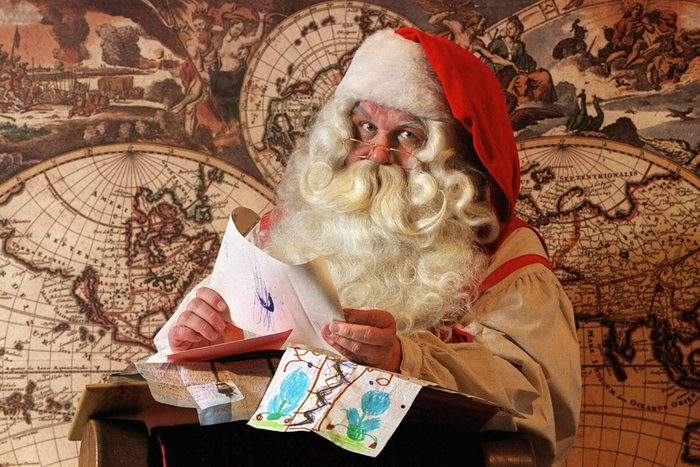
MARTTI KAINULAINEN/Getty Images
How Santa is celebrated throughout the world
OK, so you know how St. Nicholas became Santa Claus in America, but is Santa real anywhere else around the world? Although many countries have their own Santa-like figures who give gifts to little boys and girls, they’ve increasingly been mingled with the American Santa over the years. “Santa Claus via St. Nicholas gets to American shores, and through Nast and Irving and ‘A Visit from Saint Nicholas,’ and then all the movies and TV shows and Coke advertisements, gets transformed and Americanized and then gets shipped around the entire world as another great cultural imperialist act of the United States,” Thompson says. From his roots in the Netherlands, the American Santa Claus has come full circle and now influences Europe and the rest of the globe.
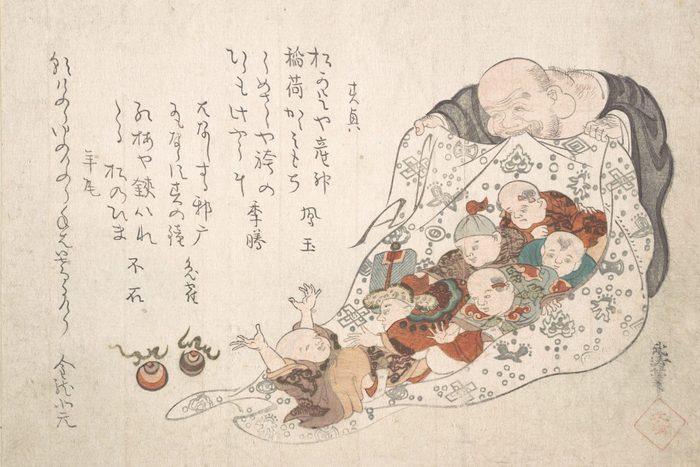
Heritage Images/Getty Images
Santa in Japan
Nowhere has Santa as an American import taken hold quite like in Japan. “When you go to Japan, you’ll see an American Santa Claus imported mostly through decades and decades of presentation in mass media, film and television,” Thompson says. Santa and Christmas in Japan, though, are completely secular, as the majority of the country is not Christian. The Buddhist figure of Hotei, who brings presents for the new year, is sometimes called the Japanese Santa, as the two share similarities in character and appearance.
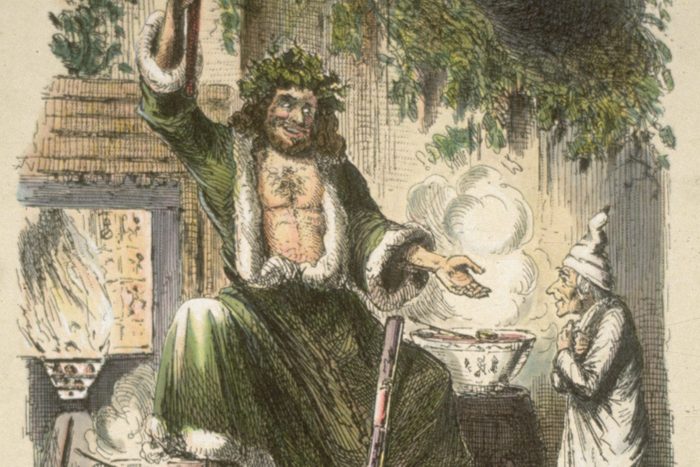
Hulton Archive/Getty Images
Santa in England
England’s Father Christmas started not as a saint but as a festive allegorical figure clad in green who epitomized the “making merry” part of Christmas. In Charles Dickens’s classic Christmas book A Christmas Carol, which helped create the modern holiday, there is no Father Christmas or Santa—but the Ghost of Christmas Present is very similar. “If you look at the pictures that originally accompanied that story, he looks a lot like Santa Claus: bearded, jolly, but he’s merry old Christmas. He’s not Santa Claus. That name is never mentioned at all.” Eventually, though, Father Christmas and the American Santa became one and the same.
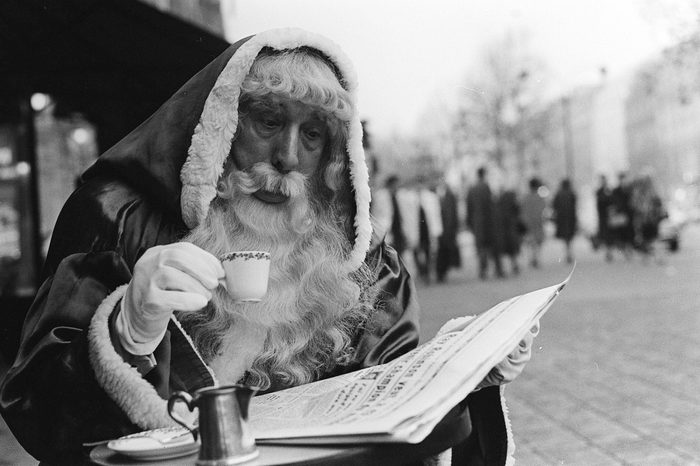
Mirrorpix/Getty Images
Santa in France
The French Père Noël, which translates to Father Christmas, is a mashup of that figure and St. Nicholas. Instead of hanging stockings, French children put out their shoes or slippers on Christmas Eve in the hopes of having them filled with little gifts. Père Noël doesn’t have reindeer—instead, he rides a donkey.
The French also celebrate St. Nick’s feast day on Dec. 6, particularly in the Alsace region. “People bake a sweet brioche bread or large biscuits in the form of a little man, or in French, mannala, to represent St. Nicholas,” says Amelia Brown, a professor of Greek history and language at the University of Queensland in Australia who has studied St. Nicholas extensively. “These ‘little men’ and other lollies are given to children during a parade, which ends with eating these sweet gifts and drinking hot chocolate in the cold winter air.”
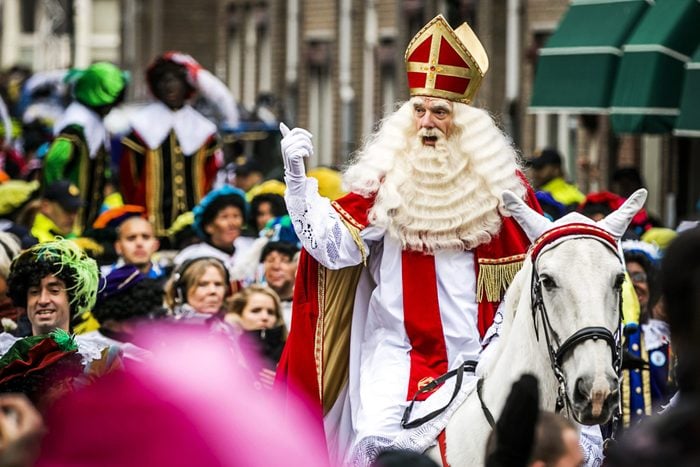
REMKO DE WAAL/Getty Images
Santa in the Netherlands
Sinterklaas is still celebrated in the Netherlands on St. Nicholas’s feast day, Dec. 6. He shares some similarities with Santa, such as his white beard, but he’s dressed as a bishop in traditional Catholic red robes (this is also why Santa Claus wears red, one of the traditional Christmas colors). Sinterklaas rides a white horse, a holdover from the Norse god Odin, who flew on a horse during the winter solstice celebration of Yule. Since St. Nicholas’s feast day was near the solstice, it was also combined with elements of solstice holidays, Brown says.
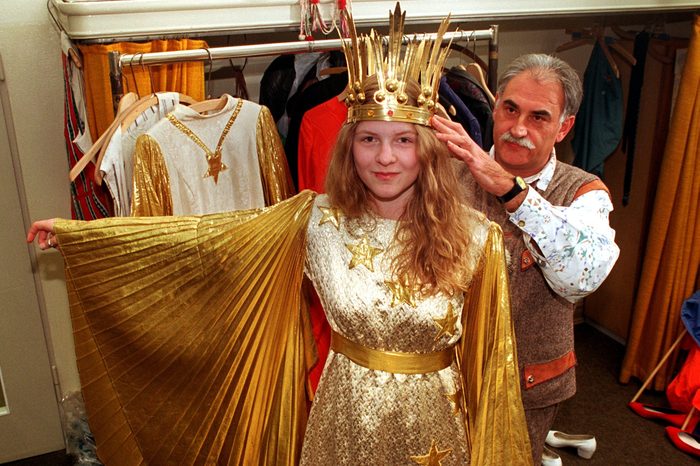
picture alliance/Getty Images
Santa in Germany
Although Germany incorporates some aspects of St. Nicholas and Santa Claus, Germans also have their own twist. The holiday figure of Christkindl is a 16th-century Protestant attempt to move the gift-giving from the Catholic feast of St. Nick to Christmas. “With the Christ child, the gift giver is baby Jesus himself,” Thompson says.
Confusingly, Christkindl transformed over time into a female angel with golden hair and a crown. The term Christkindl is also where we get the English name Kris Kringle, another moniker for Santa.
German tradition also gives us the alter ego to Santa: Krampus, a malevolent figure who comes after naughty children. “There’s the evil Krampus, which is getting very much attention and getting rediscovered, turning [the holiday] into horror,” Thompson says. This original bad Santa likely came from pagan traditions around the winter solstice. Today, people dressed as the sinister spirit still parade on Krampusnacht, or Krampus Night, Dec. 5.
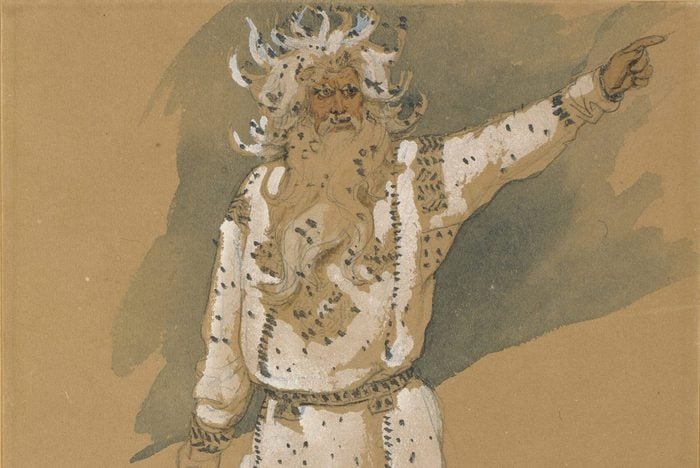
Heritage Images/Getty Images
Santa in Russia
Although similar in appearance, Russia’s Ded Moroz, or “Grandfather Frost,” is not exactly connected to St. Nicholas but is tied to pagan folklore. Thinner than Santa and sometimes dressed in blue, he brings presents on New Year’s. “There have always been these mystical, giving spirits of the solstice and midwinter that have manifested in many kinds of ways,” Thompson says. “After the Russian Revolution [in the 1920s], they tried to transfer [St. Nick] to the idea of these winter spirits and father winter” in order to curtail religious celebrations.
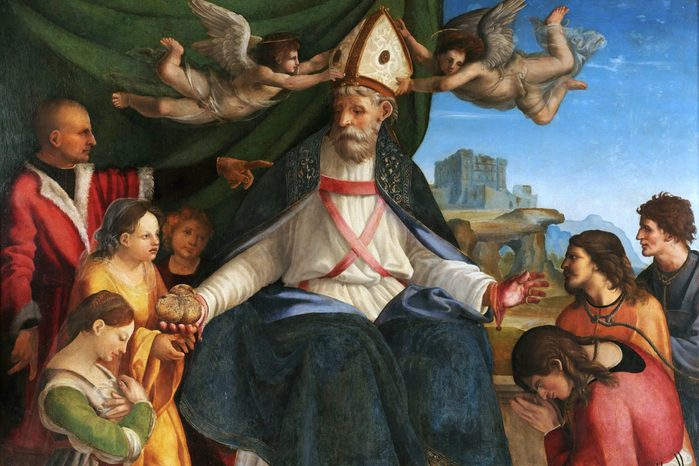
Heritage Images/Getty Images
Santa in Greece
For some countries, St. Nicholas remains the top dog of holiday figures. “In modern Greece and other Orthodox countries and communities, Dec. 6 is celebrated as St. Nicholas’s feast day, with services in church in honor of his death in the year 343,” Brown says. “There are also many other traditions, especially gift-giving to and by people with this ‘name day,’ so Nicholases or Nicoles or Nicks. You greet them in Greece with Chronia Polla, ‘May you live many years!'” Fittingly, cities with St. Nicholas as their patron saint, such as New York and Amsterdam, also hold a festival for the celebration of the day, she says.

SolStock/Getty Images
The future of Santa
Today, we’re thinking about Santa in new and different ways, with the idea that he can manifest as people of different colors—or maybe even female. “We’re beginning to rethink and re-examine Santa Claus’s origins and not to take him simply back to New York, the American Santa, but to tie into St. Nicholas,” Thompson says. “And that brings us to the notion of a much more diverse idea of what Santa Claus was that didn’t come just from a very specific strain of American literature and then American Madison Avenue.”
Looking at his history, St. Nick and Santa have been so many things over the centuries, it doesn’t make sense to pigeonhole them. “Now we’ve got a sense of what the poems and the movies have been telling us from the beginning: that Santa Claus is an idea, a spirit, a representation of something bigger and more wonderful, and that can embody itself in any number of different ways,” Thompson says.
About the experts
- Robert Thompson is a trustee professor of television, radio and film at the Newhouse School of Public Communications at Syracuse University. He is also the director of the school’s Bleier Center for Television and Popular Culture and the editor of an ongoing series of books about television published by Syracuse University Press. Santa Claus is one of his favorite subjects.
- Amelia Brown, PhD, is a professor of Greek history and language in the Classics and Ancient History discipline of the School of Historical and Philosophical Inquiry at the University of Queensland in Australia, as well as the director of the R.D. Milns Antiquities Museum at the university. She has studied St. Nicholas extensively and is currently in Greece doing research.
Sources:
- University of Oxford: “Could ancient bones suggest Santa was real?”
- The Coca-Cola Company: “Haddon Sundblom and the Coca-Cola Santas”
- New York Public Library: “Santa’s New York Roots”
- English Heritage: “The History of Father Christmas”